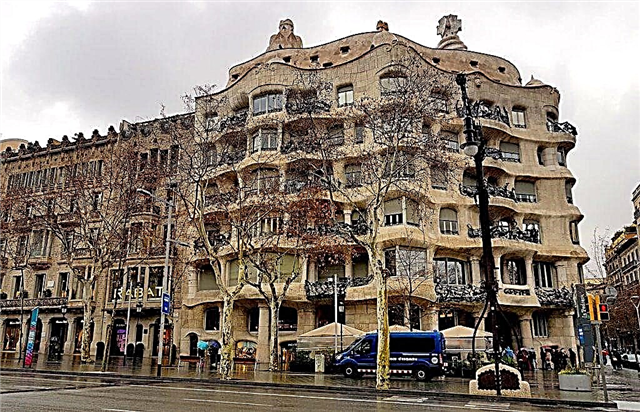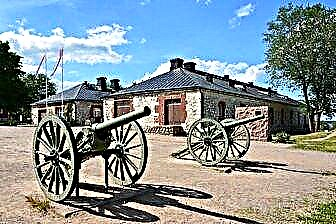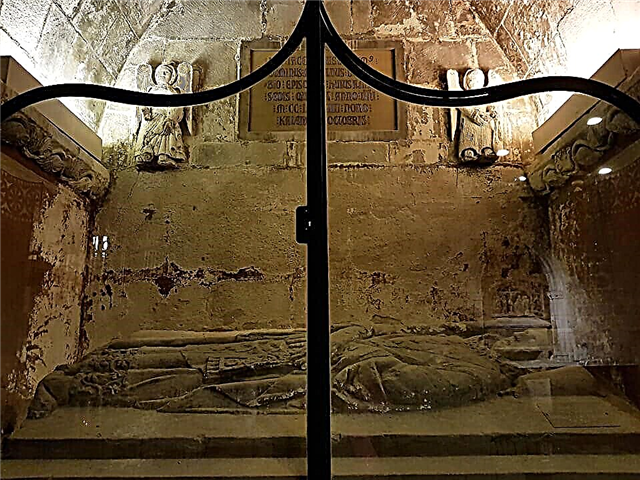On the territory of the old Gothic quarter of the Catalan capital, there is the main temple of the city - the Cathedral of the Holy Cross and Saint Eulalia. The name "cathedral" indicates the presence of an episcopal see in it. Thus, the service in the basilica on holidays is conducted by the high priest of Catalonia.
The main attraction of the Gothic Quarter

The temple is dedicated to the memory of Saint Eulalia, who was martyred for the faith of Christ in the 4th century. AD Under the emperor Diocletian, Christians were severely persecuted. Young Eulalia tried to persuade the Roman governor not to harm her fellow believers. However, she was thrown into prison and subjected to all kinds of torture. They wanted to force the girl to renounce her faith in the Mission. Eulalia did not give in and died in a prison.
The main cathedral of Barcelona was erected in memory of the martyr. Her relics are one of the main shrines of the church. The second shrine that gave the name to the temple is the cross with the image of the crucified Jesus. During the decisive naval battle between the Christian and Muslim flotillas in 1571, the cross adorned the bow of the flagship. The sacred relic is kept in the Chapter Hall.

The capitular hall serves as a venue for important meetings and also houses a mini-museum with valuable works of art. According to the decree of Pope Pius IX (1867), the cathedral bears the honorary title of the Little Papal Basilica. At the end of the 20s. of the last century, the object received the status of "a monument of history and art of national importance."
Cathedral of Saint Eulalia
The first buildings on the territory of the present temple complex appeared at the end of the 13th century. The oldest surviving structure is the chapel of St. Lucia. It dates back to 1268. The construction of the basilica was started in 1298. The site with the foundations of a temple from the ancient Roman era (4th century) was chosen as the site for the construction.
Engineering, construction and finishing works stretched for 150 years. The building was completed by 1460. However, in the following centuries, the complex was supplemented with new elements. The main entrance to the basilica was erected in 1870. The central spire, crowning the dome, appeared in 1913. The dimensions of the sanctuary are impressive.
| Cathedral and its parts | Length, m | Width, m | Height, m |
| Outside | 93 | 40 | Dome-70 |
| Inside | 79 | 25 | Dome-41 |
| Central nave | 28 | 13 | 26 |
| Side aisles | 28 | 6 | 21 |
| Chapels | 6 | 5 | 9 |
The bell tower rises to a height of about 54 meters, and the total height of the tower with a spire is 70 meters. The belfries that border the facade of the building are shaped like an octagonal. Their height is 53 m. Bells are placed on the upper platform of each tower. On the left - a giant bell weighing 3 tons. On the right - 10 small bells bearing female names.
Features of the architecture

Neo-Gothic was chosen as the main architectural style of the building. Externally, the structure is made strictly, without excessive decor. Supports, sculptures, stained glass windows are intended for decoration. The building material was marble, which was mined in Montjuie. To enter the territory of the temple, the gate of Saint Yves of Breton (patron saint of legalists) was used. They are located in the lower part of one of the towers and face towards Saint Eulalia Square, where the city court building was located in the past.
The surface of the side walls at the gate is decorated with carved bas-reliefs - the figure of a man fighting with animals and the inscription "1298". The famous Catalan architect Josep Oriol y Mestres was directly involved in designing the entrance. There are a total of 6 gates leading to the cathedral.
The most famous of them:
- St. Ivo
- St. Eulalia
- St. Lucia
- Mercy
Following the example of many Gothic structures, gutters decorated with images of sinister gargoyles were used to drain rainwater from the roof. It was believed that their frightening appearance would scare away evil forces from the sacred place.
Interior decoration

The interior space is majestic due to the equal height of the nave. There are 25 chapels along the perimeter. Visually, the temple looks wider and taller. The effect of increasing the internal area is provided by the upper galleries in the side chapels. The grandiose altar, serving as an adornment of the cathedral, was created in the 14th century. Directly below it, in the underground crypt, the remains of the holy martyr Eulalia are preserved. They are enclosed in an alabaster sarcophagus. If you throw a coin into the slot, the backlight comes on, which provides a solemn view of the opening picture.

In the vicinity of the main shrine, tombstones are erected over the graves of Count Ramon Berenguer I and his wife Almodis. The church treasury is located opposite them. It contains many valuable artifacts. The most ancient ones date back to the 15th century. In the choir of the building, a meeting of the knights of the Order of the Golden Fleece, established by Emperor Charles V, was held. In memory of the momentous event, armchairs with drawings of knightly coats of arms were left. The choirs are decorated with bas-reliefs carved from marble. They show episodes from the life of the patron saint of Barcelona.
Chapels were built next to the choirs, where in the 19th century. separate altars were erected. An elevator takes visitors straight from the chapels to the roof of the basilica. The equipped observation deck gives you the opportunity to enjoy the panorama of the city. The beauty and majesty of the building is emphasized by glass stained-glass windows in the windows. They appeared gradually, starting from the 14th to the 20th centuries. All compositions are created according to a single plan: in the center - the image of a saint, in two side parts - shields with images of angels, cities, geometric figures and other things.

Samples of Catalan art and ancient artifacts can be seen in the chapels. Each of them has its own altar in the Gothic style. The altarpieces were created by recognized masters of medieval painting: Gabriel Alemany, Luis Borrassa, Bernat Martorell and others. The treasury of the cathedral contains paintings by Bartolomé Bermejo, Jaume Gougeta, Pere Desorrenta. An important relic revered by the inhabitants of Barcelona and Catalonia is the throne of King Martin (mid 15th century). It is made of an alloy of precious metals - gold and silver, and decorated with gems.

The pride of the Church of St. Eulalia is the ancient organ. It is located in the premises of the left belfry. You can hear the sound of a musical instrument during special programs dedicated to organ music. The schedule of events is constantly updated on the official website of the cathedral.
Patio

An important part of the architectural ensemble of the Cathedral is the inner courtyard, otherwise called the cloister. Passages from the Gates of Mercy and Saint Eulalia lead to it, as well as the entrance from the side of the basilica. The layout of the courtyard and its decoration was carried out by the architect Andres Escuder. The sculptural images were created with the participation of João Claperos.
The central place in the cloister is given to a small pond, where, according to a centuries-old tradition, 13 snow-white geese live. The birds symbolize the innocence and purity of the patron saint of the temple, and their number corresponds to the number of years the girl lived. Magnolias and palms are planted around the reservoir, giving the corner a natural look. To decorate the cloister, a fountain was created, depicting the figure of St. George on horseback.
The architectural structures included in the common temple complex include:
- Chapel of Saint Lucia
- Chapter Hall
- Monastery
Working hours
Access to the Cathedral is open daily. The exact times of visits for religious and educational purposes are indicated in the table:
Time Mon.-Fri. Sat. Sun.
| Time | Mon-Fri | Sat. | Sun. |
| Prayer hours | 8:30 -12: 30 and 17:45 -19: 30 | 8:30 12:30 and 17: 15-20: 00 | 8:30 -13: 45 and 17: 15- 20:00 |
| Excursion hours | 12:30 -19:45 | 12:30 -17:30 | 14:00 -17:30 |
The terrace can be accessed during a guided tour from Monday to Saturday (10:00 am - 12:00 pm).
During the service, the entrance to the cathedral and the monastery is free. Tourists are expected to visit in the afternoon. There is a 7 € inspection fee.
Where is it located and how to get there
The cathedral is located in the square of Saint Eulalia (de la Seu). Tourists can get into it using overground or underground transport:
- bus 45 (to via Laietana - pl. Ramon Berenguer)
- bus 120 (to via Laietana)
- tourist bus - red direction (to Barri Gotic)
- metro - yellow direction L4, (to Jaume I).











